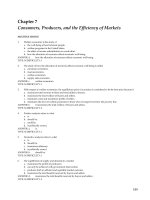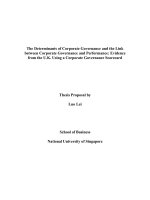Lecture Principles of economics - Chapter 3: Consumers, producers, and the efficiency of markets
Bạn đang xem bản rút gọn của tài liệu. Xem và tải ngay bản đầy đủ của tài liệu tại đây (706 KB, 43 trang )
3
SUPPLY AND DEMAND II: MARKETS AND WELFARE
Consumers,
Producers, and the
Efficiency of Markets
Copyright © 2004 South-Western
7
REVISITING THE MARKET
EQUILIBRIUM
• Do the equilibrium price and quantity
maximize the total welfare of buyers and
sellers?
• Market equilibrium reflects the way markets
allocate scarce resources.
• Whether the market allocation is desirable can
be addressed by welfare economics.
Copyright © 2004 South-Western
Welfare Economics
• Welfare economics is the study of how the
allocation of resources affects economic well
being.
• Buyers and sellers receive benefits from taking
part in the market.
• The equilibrium in a market maximizes the
total welfare of buyers and sellers.
Copyright © 2004 South-Western
Welfare Economics
• Equilibrium in the market results in maximum
benefits, and therefore maximum total welfare
for both the consumers and the producers of the
product.
Copyright © 2004 South-Western
Welfare Economics
• Consumer surplus measures economic welfare
from the buyer’s side.
• Producer surplus measures economic welfare
from the seller’s side.
Copyright © 2004 South-Western
CONSUMER SURPLUS
• Willingness to pay is the maximum amount that
a buyer will pay for a good.
• It measures how much the buyer values the
good or service.
Copyright © 2004 South-Western
CONSUMER SURPLUS
• Consumer surplus is the buyer’s willingness to
pay for a good minus the amount the buyer
actually pays for it.
Copyright © 2004 South-Western
Table 1 Four Possible Buyers’ Willingness to Pay
Copyright©2004 South-Western
CONSUMER SURPLUS
• The market demand curve depicts the various
quantities that buyers would be willing and able
to purchase at different prices.
Copyright © 2004 South-Western
The Demand Schedule and the
Demand Curve
Copyright © 2004 South-Western
Figure 1 The Demand Schedule and the Demand Curve
Price of
Album
John’s willingness to pay
$100
Paul’s willingness to pay
80
George’s willingness to pay
70
Ringo’s willingness to pay
50
Demand
0
1
2
3
4
Quantity of
Albums
Copyright©2003 Southwestern/Thomson Learning
Figure 2 Measuring Consumer Surplus with the Demand
Curve
(a) Price = $80
Price of
Album
$100
John’s consumer surplus ($20)
80
70
50
Demand
0
1
2
3
4
Quantity of
Albums
Copyright©2003 Southwestern/Thomson Learning
Figure 2 Measuring Consumer Surplus with the Demand
Curve
(b) Price = $70
Price of
Album
$100
John’s consumer surplus ($30)
80
Paul’s consumer
surplus ($10)
70
50
Total
consumer
surplus ($40)
Demand
0
1
2
3
4 Quantity of
Albums
Copyright©2003 Southwestern/Thomson Learning
Using the Demand Curve to Measure
Consumer Surplus
• The area below the demand curve and above
the price measures the consumer surplus in the
market.
Copyright © 2004 South-Western
Figure 3 How the Price Affects Consumer Surplus
(a) Consumer Surplus at Price P
Price
A
Consumer
surplus
P1
B
C
Demand
0
Q1
Quantity
Copyright©2003 Southwestern/Thomson Learning
Figure 3 How the Price Affects Consumer Surplus
(b) Consumer Surplus at Price P
Price
A
Initial
consumer
surplus
P1
P2
0
C
B
Consumer surplus
to new consumers
F
D
E
Additional consumer
surplus to initial
consumers
Q1
Demand
Q2
Quantity
Copyright©2003 Southwestern/Thomson Learning
What Does Consumer Surplus Measure?
• Consumer surplus, the amount that buyers are
willing to pay for a good minus the amount
they actually pay for it, measures the benefit
that buyers receive from a good as the buyers
themselves perceive it.
Copyright © 2004 South-Western
PRODUCER SURPLUS
• Producer surplus is the amount a seller is paid
for a good minus the seller’s cost.
• It measures the benefit to sellers participating in
a market.
Copyright © 2004 South-Western
Table 2 The Costs of Four Possible Sellers
Copyright©2004 South-Western
Using the Supply Curve to Measure Producer
Surplus
• Just as consumer surplus is related to the
demand curve, producer surplus is closely
related to the supply curve.
Copyright © 2004 South-Western
The Supply Schedule and the
Supply Curve
Copyright © 2004 South-Western
Figure 4 The Supply Schedule and the Supply Curve
Using the Supply Curve to Measure Producer
Surplus
• The area below the price and above the supply
curve measures the producer surplus in a
market.
Copyright © 2004 South-Western
Figure 5 Measuring Producer Surplus with the Supply
Curve
(a) Price = $600
Price of
House
Painting
Supply
$900
800
600
500
Grandma’ s producer
surplus ($100)
0
1
2
3
4
Quantity of
Houses Painted
Copyright©2003 Southwestern/Thomson Learning









